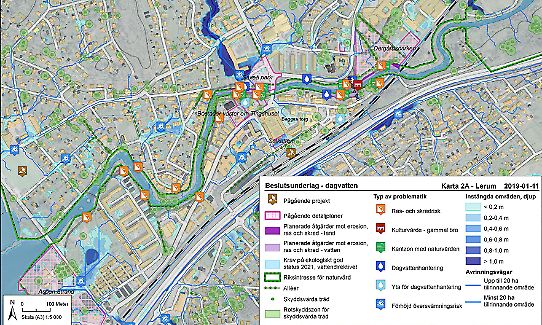One consequence of the ongoing climate change is the increasing frequency of extreme weather, in the form of sudden heavy rain and heatwaves. As the conditions change, society also needs to change accordingly. Climate adaptation is therefore an important element of social planning. When new construction or renovation projects are being established, consideration to climate adaptation needs to be included.
Climate adaptation affects all the areas that are involved in a municipality’s social planning process – for example, it could be that the management of surface runoff must be taken into consideration as sudden cloudbursts of heavy rain will become more common as the climate changes. Several of the areas affected by climate adaptation may also overlap. If these are managed on an individual basis, they risk coming into conflict with each other. By means of cooperation between these areas, conflicts of interest can be avoided and common solutions can be found.
Need for collaboration in Lerum
In Lerum Municipality, the climate adaptation strategist felt that the municipality lacked consensus with regard to climate adaptation issues. There was no structured way of ensuring that climate adaptation had been taken into account in the development of solutions for managing surface runoff, geotechnics or nature conservation. Although they can affect each other, these areas were also managed by different agents. Solutions that were developed in different areas would not therefore necessarily be compatible with each other. One of the problems involved organisational failings in the municipality. No routines had been established for how the planning and project unit should seek expert advice in the areas of surface runoff, geotechnics, nature conservation and climate adaptation.
Expert group as a solution
It was clear that there was a need for a forum, where experts could collaborate and support the social planning. They therefore established a group comprising members from each of the areas within social planning that affect each other. The areas presently being managed in the group are climate adaptation, geotechnics, nature conservation and surface runoff. The members include a climate adaptation strategist, a nature conservation officer and a water and sanitation engineer with specialist knowledge of surface runoff. Because Lerum experiences problems with landslides, it was appropriate to also include a geotechnician in the group.
Planning architects, project managers, land and exploitation engineers and other agents within social planning have the opportunity to book meetings where they can discuss issues with the experts. They can also commission the group to provide support in the production of preliminary documentation or the scrutiny of planning documents.

The expert group makes the planning process easier, and ensures that conflicting goals are sorted out at the start. Costs and time that would otherwise need to be devoted to the resolution of problems at a later stage of a project can therefore be avoided. By collaborating, the expert group can also create solutions that work for all.
More examples of climate adaptation
This is one of many examples of climate adaptation. There are more in the collection of ideas being built up by the Swedish National Knowledge Centre for Climate Change Adaptation at the Swedish Meteorological and Hydrological Institute (SMHI). The collection of examples has the aim of sharing experiences and providing ideas to everyone who works with climate adaptation. Examples describe concrete measures and challenges in several subject areas. They show how different actors have worked to adapt their activities to the climate changes that are already being noticed today and those that we cannot prevent in the future.